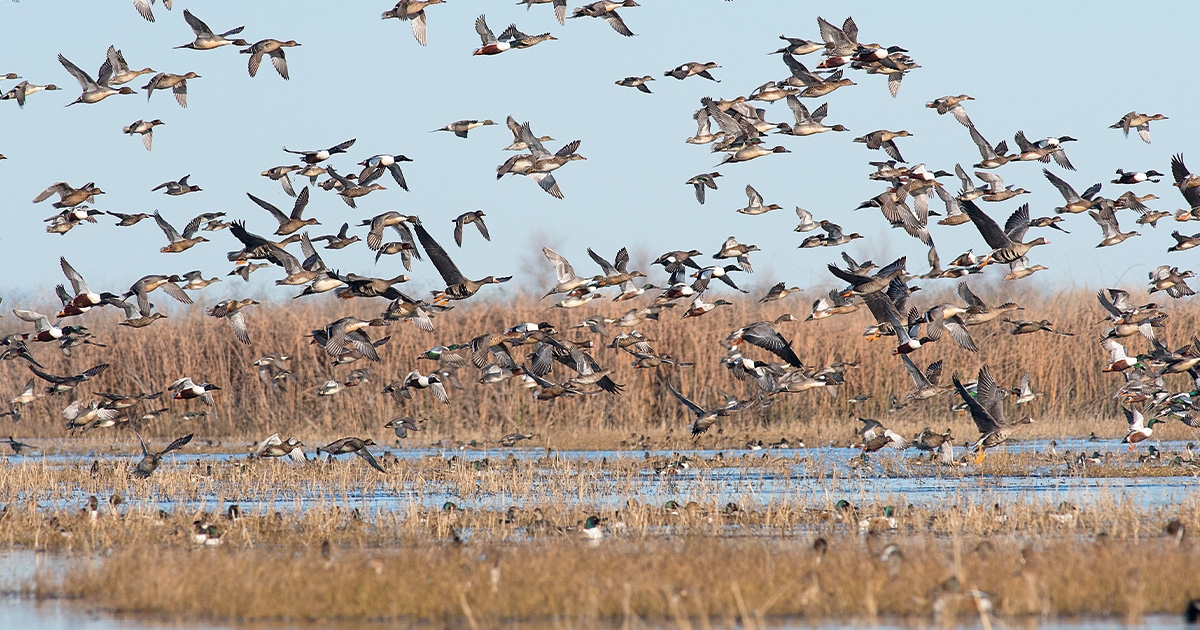Field Reports: 2024 Early-Spring Habitat Report
An overview of wetland conditions across key waterfowl breeding areas
An overview of wetland conditions across key waterfowl breeding areas
By DU Field Biologists

Data shows Palmer Drought Indices with categories consolidated and colored to match current conditions. Climate Engine. 2024. Desert Research Institute and University of Idaho. Accessed on April 2, 2024. HTTP://CLIMATEENGINE.ORG. NOAA National Centers for Environmental Information and Agriculture and Agri-Food Canada.
With a snowpack that is approximately 75 percent of normal, spring runoff is expected to be below average across much of British Columbia, and the threat of summer drought remains high due to lingering dry conditions from last year. The timing of the spring waterfowl migration was typical along the coast. In the interior, waterfowl began arriving in late March, which is ahead of schedule.
Southern portions of the Boreal region generally received below-average winter snowfall, and dry conditions will likely prevail in many areas this spring. To the north, in the Yukon, most ponds were full at freeze-up, and spring wetland conditions are likely to be good for breeding waterfowl.

Frequent warm spells eroded snow cover across much of Prairie Canada this winter, limiting runoff potential in many areas.
With help from significant snowfall in March, annual precipitation has been near or above average across much of Prairie Canada. Due to low soil moisture and midwinter thaws, however, much of the moisture has already soaked into the soil. Drought conditions are expected to persist, and significant precipitation will be needed to replenish soil moisture and recharge wetland basins for breeding waterfowl across most of this region.
Winter precipitation was above average across northern portions of Ontario and Quebec, while drier conditions prevailed across the south. Nevertheless, most permanent and seasonal wetlands remain near full capacity, which will likely provide good habitat for breeding waterfowl. The spring migration was well under way by mid-March, and tundra swans, Canada geese, and ducks were congregating on recently thawed wetlands.

Despite below-average winter precipitation in southern Ontario, many wetlands remain near full capacity.
Spring arrived early in Atlantic Canada, and many wetlands had thawed by mid-March. Early migrants such as mallards, American black ducks, and Canada geese are already occupying wetlands with open water, resulting in an early start to the breeding season. Wetlands remain at good levels in many areas and should provide favorable habitat for migrating and breeding waterfowl this spring.
The eastern Dakotas received below-average winter snowfall, and warm temperatures have left most temporary wetland basins completely dry. Some permanent wetlands and reservoirs are in better condition, but the Dakotas will need significant spring precipitation to provide good breeding habitat for waterfowl. Northeast Montana is in similar shape—moisture has been adequate for grass production but depressional wetlands are largely dry.

Wetland conditions have improved dramatically across much of the West, providing good habitat for migrating and breeding waterfowl.
While wetland conditions are much improved in the northeast, dry weather has persisted across the Great Lakes, where pervasive moderate to extreme drought continues. Significant precipitation will be needed to improve spring habitat conditions for breeding waterfowl in this region. Relatively mild temperatures have led to an early start to the breeding season, with reports of resident Canada geese and mallards already nesting in some areas.
Spring habitat conditions appear to be good throughout the West, including improved wetland conditions in the Klamath Basin. This should benefit breeding waterfowl throughout the region. In Alaska, winter snow levels, while highly variable, are in good shape across much of the state, boding well for breeding waterfowl.
Ducks Unlimited uses cookies to enhance your browsing experience, optimize site functionality, analyze traffic, and deliver personalized advertising through third parties. By continuing to use this site, you agree to our use of cookies. View Privacy Policy